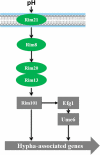The regulation of hyphae growth in Candida albicans
- PMID: 32274962
- PMCID: PMC7161696
- DOI: 10.1080/21505594.2020.1748930
The regulation of hyphae growth in Candida albicans
Abstract
In the last decades, Candida albicans has served as the leading causal agent of life-threatening invasive infections with mortality rates approaching 40% despite treatment. Candida albicans (C. albicans) exists in three biological phases: yeast, pseudohyphae, and hyphae. Hyphae, which represent an important phase in the disease process, can cause tissue damage by invading mucosal epithelial cells then leading to blood infection. In this review, we summarized recent results from different fields of fungal cell biology that are instrumental in understanding hyphal growth. This includes research on the differences among C. albicans phases; the regulatory mechanism of hyphal growth, extension, and maintaining cutting-edge polarity; cross regulations of hyphal development and the virulence factors that cause serious infection. With a better understanding of the mechanism on mycelium formation, this review provides a theoretical basis for the identification of targets in candidiasis treatment. It also gives some reference to the study of antifungal drugs.
Keywords: Candida albicans; Oral candidiasis; fungi; hyphae; mycelium.
Figures









References
Publication types
MeSH terms
Substances
LinkOut - more resources
Full Text Sources
